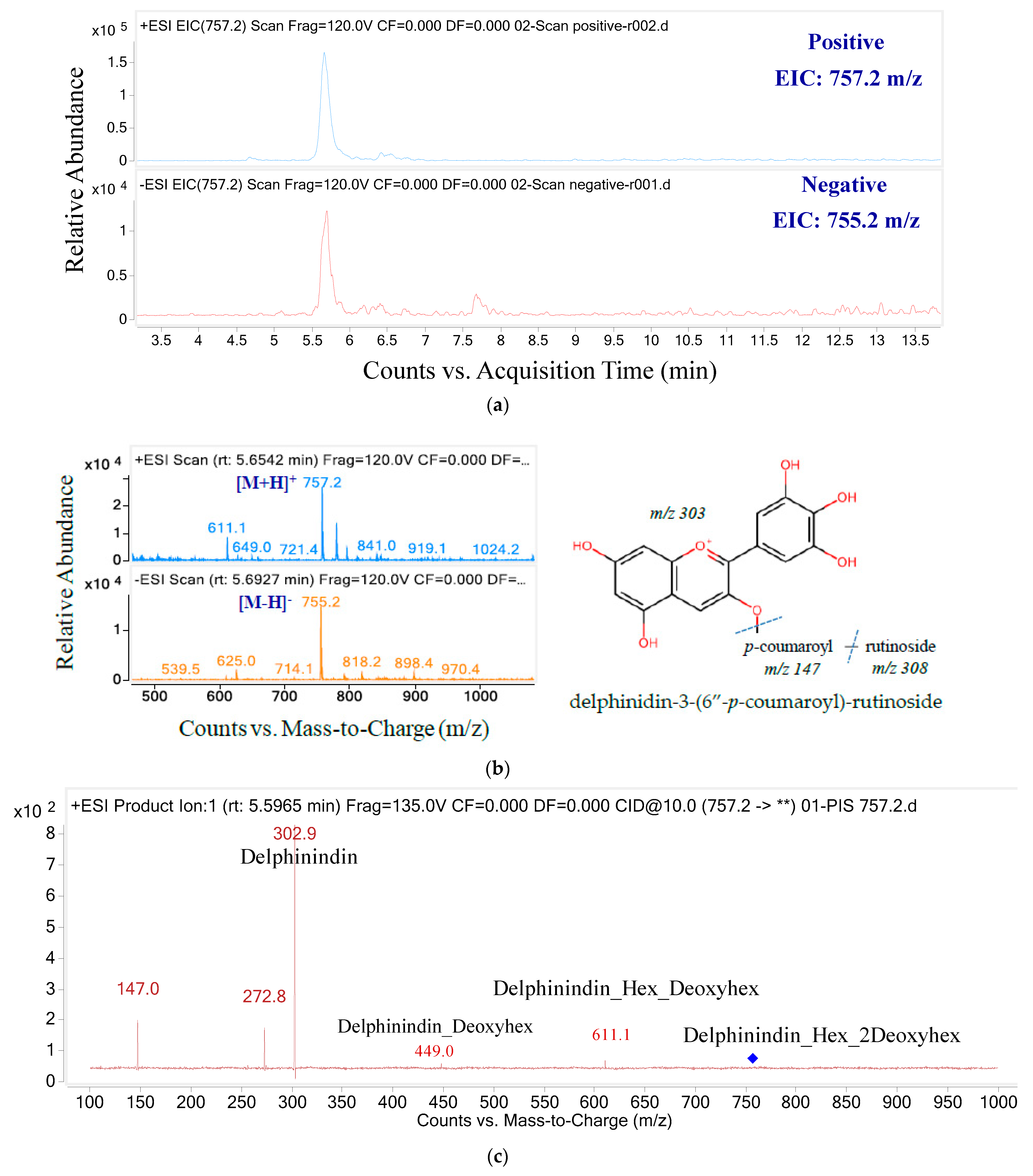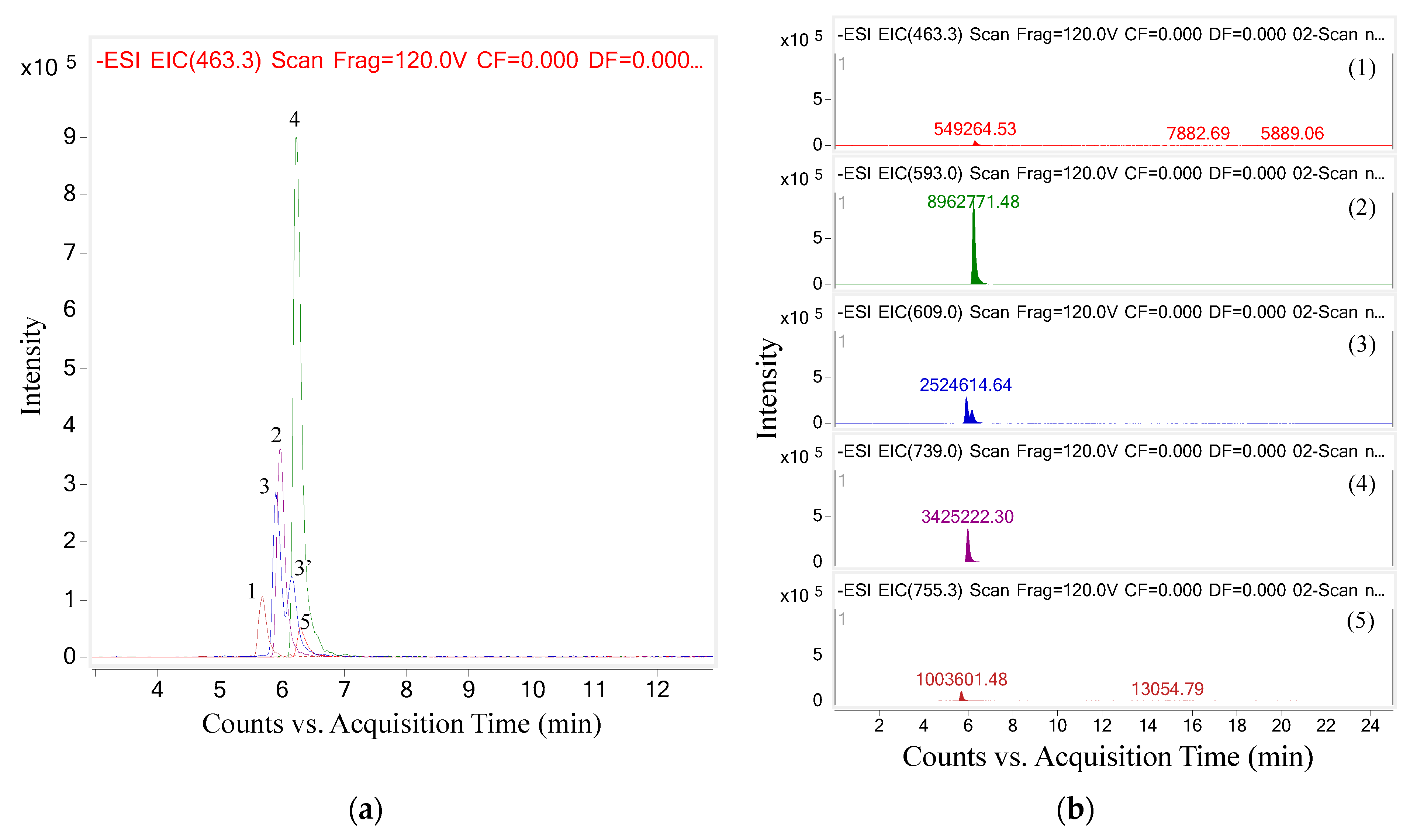Identification of Anthocyanin Compounds in Butterfly Pea Flowers (Clitoria ternatea L.) by Ultra Performance Liquid Chromatography/Ultraviolet Coupled to Mass Spectrometry
Abstract
1. Introduction
2. Results and Discussion
3. Materials and Methods
3.1. Chemicals and Materials
3.2. Ultra Performance Liquid Chromatography/Ultraviolet/Mass Spectrometry (UPLC/UV/MS) Analysis
3.2.1. Extraction
3.2.2. Purification Procedure
3.2.3. The UPLC/UV/MS Conditions
4. Conclusions
Author Contributions
Funding
Institutional Review Board Statement
Informed Consent Statement
Data Availability Statement
Acknowledgments
Conflicts of Interest
References
- Nair, V.; Bang, W.Y.; Schreckinger, E.; Andarwulan, N.; Cisneros-Zevallos, L. Protective Role of Ternatin Anthocyanins and Quercetin Glycosides from Butterfly Pea (ClitoriaTernatea Leguminosae) Blue Flower Petals against Lipopolysaccharide (LPS)-Induced Inflammation in Macrophage Cells. J. Agric. Food Chem 2015, 63, 6355–6365. [Google Scholar] [CrossRef]
- Campbell, S.M.; Pearson, B.; Marble, S.C. Butterfly Pea (ClitoriaTernatea) Flower Extract (BPFE) and Its Use as a PH-Dependent Natural Colorant. EDIS 2019, 2019. [Google Scholar] [CrossRef]
- Kazuma, K.; Noda, N.; Suzuki, M. Flavonoid Composition Related to Petal Color in Different Lines of Clitoria ternatea. Phytochemistry 2003, 64, 1133–1139. [Google Scholar] [CrossRef]
- Rein, M. Copigmentation Reactions and Color Stability of Berry Anthocyanins. Ph.D. Thesis, University of Helsinki, Helsinki, Finland, 2005. [Google Scholar]
- Chu, B.-S.; Wilkin, J.; House, M.; Roleska, M.; Lemos, M. Effect of Sucrose on Thermal and PH Stability of ClitoriaTernatea Extract. Int. J. Food Process. Technol 2016, 3, 11–17. [Google Scholar] [CrossRef]
- Siti Azima, A.M.; Noriham, A.; Manshoor, N. Phenolics, Antioxidants and Color Properties of Aqueous Pigmented Plant Extracts: ArdisiaColorata Var. Elliptica, ClitoriaTernatea, Garcinia Mangostana and SyzygiumCumini. J. Funct. Foods 2017, 38, 232–241. [Google Scholar] [CrossRef]
- Horbowicz, M.; Kosson, R.; Grzesiuk, A.; Dębski, H. Anthocyanins of Fruits and Vegetables—Their Occurrence, Analysis and Role in Human Nutrition. J. Fruit Ornam. Plant Res. 2008, 68, 5–22. [Google Scholar] [CrossRef]
- Wu, X.; Beecher, G.R.; Holden, J.M.; Haytowitz, D.B.; Gebhardt, S.E.; Prior, R.L. Concentrations of Anthocyanins in Common Foods in the United States and Estimation of Normal Consumption. J. Agric. Food Chem 2006, 54, 4069–4075. [Google Scholar] [CrossRef]
- Routray, W.; Orsat, V. Blueberries and Their Anthocyanins: Factors Affecting Biosynthesis and Properties. Compr. Rev. Food Sci. Food Saf. 2011, 10, 303–320. [Google Scholar] [CrossRef]
- Barnes, J.S.; Nguyen, H.P.; Shen, S.; Schug, K.A. General Method for Extraction of Blueberry Anthocyanins and Identification Using High Performance Liquid Chromatography–Electrospray Ionization-Ion Trap-Time of Flight-Mass Spectrometry. J. Chromatogr. A 2009, 1216, 4728–4735. [Google Scholar] [CrossRef]
- Smeriglio, A.; Barreca, D.; Bellocco, E.; Trombetta, D. Chemistry, Pharmacology and Health Benefits of Anthocyanins: Anthocyanins and Human Health. Phytother. Res. 2016, 30, 1265–1286. [Google Scholar] [CrossRef]
- Fanali, C.; Dugo, L.; D’Orazio, G.; Lirangi, M.; Dachà, M.; Dugo, P.; Mondello, L. Analysis of Anthocyanins in Commercial Fruit Juices by Using Nano-Liquid Chromatography-Electrospray-Mass Spectrometry and High-Performance Liquid Chromatography with UV-Vis Detector: Liquid Chromatography. J. Sep. Sci. 2011, 34, 150–159. [Google Scholar] [CrossRef]
- Castañeda-Ovando, A.; Pacheco-Hernández, M.d.L.; Páez-Hernández, M.E.; Rodríguez, J.A.; Galán-Vidal, C.A. Chemical Studies of Anthocyanins: A Review. Food Chem. 2009, 113, 859–871. [Google Scholar] [CrossRef]
- De Pascual-Teresa, S.; Moreno, D.A.; García-Viguera, C. Flavanols and Anthocyanins in Cardiovascular Health: A Review of Current Evidence. Int. J. Mol. Sci. 2010, 11, 1679–1703. [Google Scholar] [CrossRef] [PubMed]
- Clifford, M.N. Anthocyanins—Nature, Occurrence and Dietary Burden. J. Sci. Food Agric. 2000, 80, 1063–1072. [Google Scholar] [CrossRef]
- Lee, J.; Rennaker, C.; Wrolstad, R.E. Correlation of Two Anthocyanin Quantification Methods: HPLC and Spectrophotometric Methods. Food Chem. 2008, 110, 782–786. [Google Scholar] [CrossRef]
- Khoo, H.E.; Azlan, A.; Tang, S.T.; Lim, S.M. Anthocyanidins and Anthocyanins: Colored Pigments as Food, Pharmaceutical Ingredients, and the Potential Health Benefits. Food Nutr. Res. 2017, 61, 1361779. [Google Scholar] [CrossRef]
- Terahara, N.; Saito, N.; Honda, T.; Toki, K.; Osajima, Y. Structure of Ternatin D1, an Acylated Anthocyanin from Flowers. Tetrahedron Lett. 1989, 30, 5305–5308. [Google Scholar] [CrossRef]
- Terahara, N.; Saito, N.; Honda, T.; Toki, K.; Osajima, Y. Further Structural Elucidation of the Anthocyanin, Deacylternatin, from Clitoria ternatea. Phytochemistry 1990, 29, 3686–3687. [Google Scholar] [CrossRef]
- Terahara, N.; Oda, M.; Matsui, T.; Osajima, Y.; Saito, N.; Toki, K.; Honda, T. Five New Anthocyanins, Ternatins A3, B4, B3, B2, and D2, from ClitoriaTernatea Flowers. J. Nat. Prod. 1996, 59, 139–144. [Google Scholar] [CrossRef]
- Terahara, N.; Toki, K.; Saito, N.; Honda, T.; Matsui, T.; Osajima, Y. Eight New Anthocyanins, Ternatins C1−C5 and D3 and Preternatins A3 and C4 from Young ClitoriatErnatea Flowers. J. Nat. Prod. 1998, 61, 1361–1367. [Google Scholar] [CrossRef]
- Escher, G.B.; Wen, M.; Zhang, L.; Rosso, N.D.; Granato, D. Phenolic Composition by UHPLC-Q-TOF-MS/MS and Stability of Anthocyanins from Clitoria ternatea L. (Butterfly Pea) Blue Petals. Food Chem. 2020, 331, 127341. [Google Scholar] [CrossRef]
- Srivastava, A.; Akoh, C.C.; Yi, W.; Fischer, J.; Krewer, G. Effect of Storage Conditions on the Biological Activity of Phenolic Compounds of Blueberry Extract Packed in Glass Bottles. J. Agric. Food Chem. 2007, 55, 2705–2713. [Google Scholar] [CrossRef] [PubMed]
- Beaulieu, J.C.; Stein-Chisholm, R.E.; Lloyd, S.W.; Bett-Garber, K.L.; Grimm, C.C.; Watson, M.A.; Lea, J.M. Volatile, Anthocyanidin, Quality and Sensory Changes in Rabbiteye Blueberry from Whole Fruit through Pilot Plant Juice Processing: Blueberry Juice Qualities through Pilot Plant Processing. J. Sci. Food Agric. 2017, 97, 469–478. [Google Scholar] [CrossRef] [PubMed]
- Nováková, L.; Spáčil, Z.; Seifrtová, M.; Opletal, L.; Solich, P. Rapid Qualitative and Quantitative Ultra High Performance Liquid Chromatography Method for Simultaneous Analysis of Twenty Nine Common Phenolic Compounds of Various Structures. Talanta 2010, 80, 1970–1979. [Google Scholar] [CrossRef]
- Ortega, N.; Romero, M.-P.; Macià, A.; Reguant, J.; Anglès, N.; Morelló, J.-R.; Motilva, M.-J. Comparative Study of UPLC–MS/MS and HPLC–MS/MS to Determine Procyanidins and Alkaloids in Cocoa Samples. J. Food Compos. Anal. 2010, 23, 298–305. [Google Scholar] [CrossRef]
- Ceymann, M.; Arrigoni, E.; Schärer, H.; Baumgartner, D.; Nising, A.B.; Hurrell, R.F. Rapid High Perform. Screening Method Using UHPLC-MS to Quantify 12 Polyphenol Compounds in Fresh Apples. Anal. Methods 2011, 3, 1774. [Google Scholar] [CrossRef]
- Wu, X.; Prior, R.L. Identification and Characterization of Anthocyanins by High-Performance Liquid Chromatography−Electrospray Ionization−Tandem Mass Spectrometry in Common Foods in the United States: Vegetables, Nuts, and Grains. J. Agric. Food Chem. 2005, 53, 3101–3113. [Google Scholar] [CrossRef] [PubMed]
- Hrazdina, G.; Iredale, H.; Mattick, L.R. Anthocyanin Composition of Brassica Oleracea Cv. Red Danish. Phytochemistry 1977, 16, 297–299. [Google Scholar] [CrossRef]
- Idaka, E.; Suzuki, K.; Yamakita, H.; Ogawa, T.; Kondo, T.; Goto, T. Structure of Monoacylated Anthocyanins Isolated from Red Cabbage, Brassica oleracea. Chem. Lett. 1987, 16, 145–148. [Google Scholar] [CrossRef]
- Fenger, J.-A.; Sigurdson, G.T.; Robbins, R.J.; Collins, T.M.; Giusti, M.M.; Dangles, O. Acylated Anthocyanins from Red Cabbage and Purple Sweet Potato Can Bind Metal Ions and Produce Stable Blue Colors. Int. J. Mol. Sci. 2021, 22, 4551. [Google Scholar] [CrossRef]
- Giusti, M.M.; Ghanadan, H.; Wrolstad, R.E. Elucidation of the Structure and Conformation of Red Radish (Raphanus Sativus) Anthocyanins Using One- and Two-Dimensional Nuclear Magnetic Resonance Techniques. J. Agric. Food Chem. 1998, 46, 4858–4863. [Google Scholar] [CrossRef]
- Mazza, G. Anthocyanins in Fruits, Vegetables, and Grains, 1st ed.; Mazza, G., Miniati, E., Eds.; CRC Press: Boca Raton, FL, USA, 2018. [Google Scholar] [CrossRef]
- Hua, Y.; Wainhaus, S.B.; Yang, Y.; Shen, L.; Xiong, Y.; Xu, X.; Zhang, F.; Bolton, J.L.; Breemen, R.B. Comparison of Negative and Positive Ion Electrospray Tandem Mass Spectrometry for the Liquid Chromatography Tandem Mass Spectrometry Analysis of Oxidized Deoxynucleosides. J. Am. Soc. Mass Spectrom. 2001, 12, 80–87. [Google Scholar] [CrossRef][Green Version]
- Sun, J.; Lin, L.; Chen, P. Study of the Mass Spectrometric Behaviors of Anthocyanins in Negative Ionization Mode and Its Applications for Characterization of Anthocyanins and Non-Anthocyanin Polyphenols: Mass Spectrometric Study of Anthocyanins in Negative Ion Mode. Rapid Commun. Mass. Spectrom. 2012, 26, 1123–1133. [Google Scholar] [CrossRef] [PubMed]
- Wang, H.; Sun, S.; Zhou, Z.; Qiu, Z.; Cui, X. Rapid Analysis of Anthocyanin and Its Structural Modifications in Fresh Tomato Fruit. Food Chem. 2020, 333, 127439. [Google Scholar] [CrossRef]
- Blázovics, A.; Kursinszki, L.; Papp, N.; Kleiner, D.; Szőke, E.; Hegyi, G.; Szilvás, A. Is Professional Prescription of a Commercially Derived Dietary Supplement in Colectomysed Patients Necessary? Eur. J. Integr. Med. 2016, 8, 219–226. [Google Scholar] [CrossRef]
- Wang, S.; Chu, Z.; Ren, M.; Jia, R.; Zhao, C.; Fei, D.; Su, H.; Fan, X.; Zhang, X.; Li, Y.; et al. Identification of Anthocyanin Composition and Functional Analysis of an Anthocyanin Activator in Solanum Nigrum Fruits. Molecules 2017, 22, 876. [Google Scholar] [CrossRef]
- Stein-Chisholm, R.; Beaulieu, J.; Grimm, C.; Lloyd, S. LC–MS/MS and UPLC–UV Evaluation of Anthocyanins and Anthocyanidins during Rabbiteye Blueberry Juice Processing. Beverages 2017, 3, 56. [Google Scholar] [CrossRef]









| Six Common Anthocyanidins: | Anthocyanidin | R1 | R2 | R3 | MW |
|---|---|---|---|---|---|
 | Pelargonidin | H | OH | H | 271 |
| Cyanidin | OH | OH | H | 287 | |
| Delphinidin | OH | OH | OH | 303 | |
| Peonidin | OMe | OH | H | 301 | |
| Petunidin | OMe | OH | OH | 317 |
| Peak | Molecular Ion [M + H]+ (m/z) | Detected Fragments (MS/MS) | Anthocyanins |
|---|---|---|---|
| 1 | 757.2 | 611.1; 449.0; 302.9; 272.8; 147.0 | Delphinidin-3-(6″-p-coumaroyl)-rutinoside |
| 2 | 741.1 | 594.8; 449.0; 286.9; 146.9 | Cyanidin 3-(6″-p-coumaroyl)-rutinoside |
| 3 | 611.2 | 302.8; 146.7 | Delphinidin-3-(cis-p-coumaroyl-glucoside) |
| 3′ | 611.1 | 464.4; 302.9 | Delphinidin-3-(trans-p-coumaroyl-glucoside) |
| 4 | 595.2 | 448.9; 287.0; 146.9 | Cyanidin-3-(p-coumaroyl)glucose |
| 5 | 465.1 | 302.9 | Delphinidin-3-pyranoside |
Publisher’s Note: MDPI stays neutral with regard to jurisdictional claims in published maps and institutional affiliations. |
© 2021 by the authors. Licensee MDPI, Basel, Switzerland. This article is an open access article distributed under the terms and conditions of the Creative Commons Attribution (CC BY) license (https://creativecommons.org/licenses/by/4.0/).
Share and Cite
Thuy, N.M.; Minh, V.Q.; Ben, T.C.; Thi Nguyen, M.T.; Ha, H.T.N.; Tai, N.V. Identification of Anthocyanin Compounds in Butterfly Pea Flowers (Clitoria ternatea L.) by Ultra Performance Liquid Chromatography/Ultraviolet Coupled to Mass Spectrometry. Molecules 2021, 26, 4539. https://doi.org/10.3390/molecules26154539
Thuy NM, Minh VQ, Ben TC, Thi Nguyen MT, Ha HTN, Tai NV. Identification of Anthocyanin Compounds in Butterfly Pea Flowers (Clitoria ternatea L.) by Ultra Performance Liquid Chromatography/Ultraviolet Coupled to Mass Spectrometry. Molecules. 2021; 26(15):4539. https://doi.org/10.3390/molecules26154539
Chicago/Turabian StyleThuy, Nguyen Minh, Vo Quang Minh, Tran Chi Ben, My Tuyen Thi Nguyen, Ho Thi Ngan Ha, and Ngo Van Tai. 2021. "Identification of Anthocyanin Compounds in Butterfly Pea Flowers (Clitoria ternatea L.) by Ultra Performance Liquid Chromatography/Ultraviolet Coupled to Mass Spectrometry" Molecules 26, no. 15: 4539. https://doi.org/10.3390/molecules26154539
APA StyleThuy, N. M., Minh, V. Q., Ben, T. C., Thi Nguyen, M. T., Ha, H. T. N., & Tai, N. V. (2021). Identification of Anthocyanin Compounds in Butterfly Pea Flowers (Clitoria ternatea L.) by Ultra Performance Liquid Chromatography/Ultraviolet Coupled to Mass Spectrometry. Molecules, 26(15), 4539. https://doi.org/10.3390/molecules26154539







